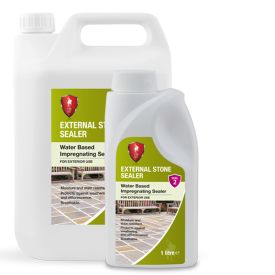
Rusty red staining around the edge of a stone paver is a relatively common issue. The tell-tale stain, which generally frames a paver, can occur for a number of reasons. These tend to be a combination of poor drainage and use of the incorrect cleaning product.
Although sandstone is a robust material, it is porous and it also has a high iron content. When the iron comes into contact with a standard cement mortar or patio cleaner it will create a red/brown blemish. Pavers that are installed onto a non-permeable surface, i.e., one that will not allow water to penetrate, will suspend moisture in brush-in permeable jointing compound. Moisture lingers and penetrates into the edge of the paver. When a patio is cleaned, the cleaning solution will leach into the open capillaries of the stone. Within the stone, the acidity of the cleaning solution then reacts with the iron in the stone, causing it to oxidise. This gives the paver a brown frame.
Rust or orange-coloured discolouration can also appear naturally within stone pavers, as the iron can oxidise or rust when it comes into contact with rain. This type of staining is often referred to as ‘iron break-out’.
To remove all types of staining, we recommend treatment with LTP Ferrex. Formulated to remove rust stains that arise from within a paver, Ferrex can be used on all types of hard ferrous stones including sandstone, granite and slate. Whilst Ferrex is an acid-based cleaner, it is the right kind of acid for harder stones. It is not the same as Brick Acid which can stain/damage pavers and accelerate oxidisation. However, it isn’t suitable for use on acid sensitive surfaces, like limestone, marble or pavers with a highly polished finish.

Before application, Ferrex should be tested on an inconspicuous area, to establish which dilution is suitable before treating the whole surface. Treatment to remove these types of stain can take between 3-6 hours.
- After testing on a small area, apply the solution to the surface and spread out evenly. For external applications garden sprayers can be used.
- For severe staining, surfaces should be agitated using a short haired scrubbing brush or black emulsifying pad.
- After 3 – 6 hours, rinse with plenty of clean water. If traces remain after a couple of days, repeat the process.
- After treatment, we recommend that the surface is protected from water with an impregnating sealer like LTP External Stone Sealer or LTP Mattstone H20. This will greatly reduce the risk of rust discolouration returning.


Some natural stones will appear darker after treatment, as the product continues to work following the initial application. This is normal and the darkening effect will gradually subside.
For more information on different types of rust stains, see our blog – The two types of rust and how to remove them.
For more advice, browse LTP TV on YouTube, contact the LTP team direct on 01823 666213, email [email protected] or visit https://www.ltp-online.co.uk



